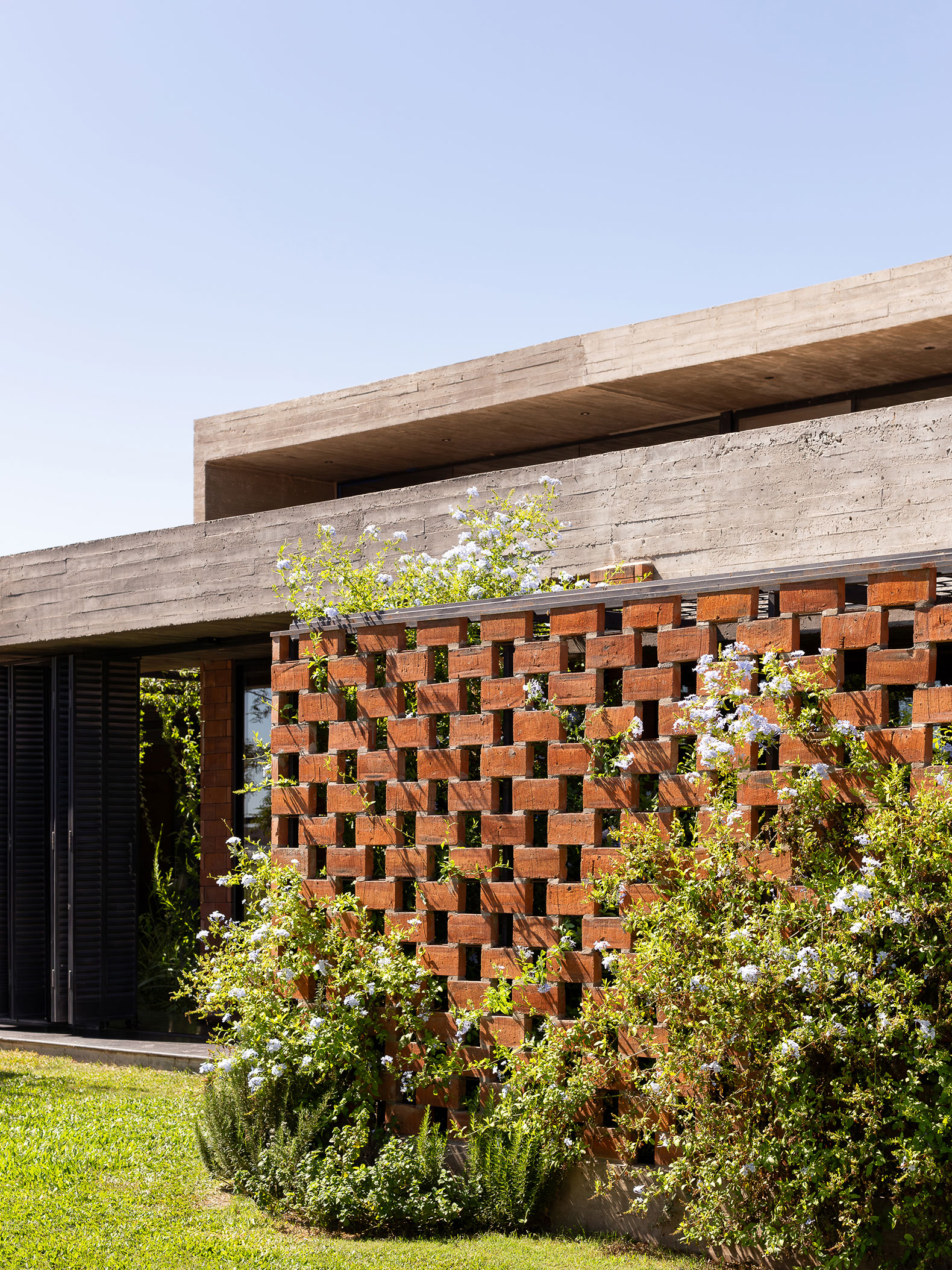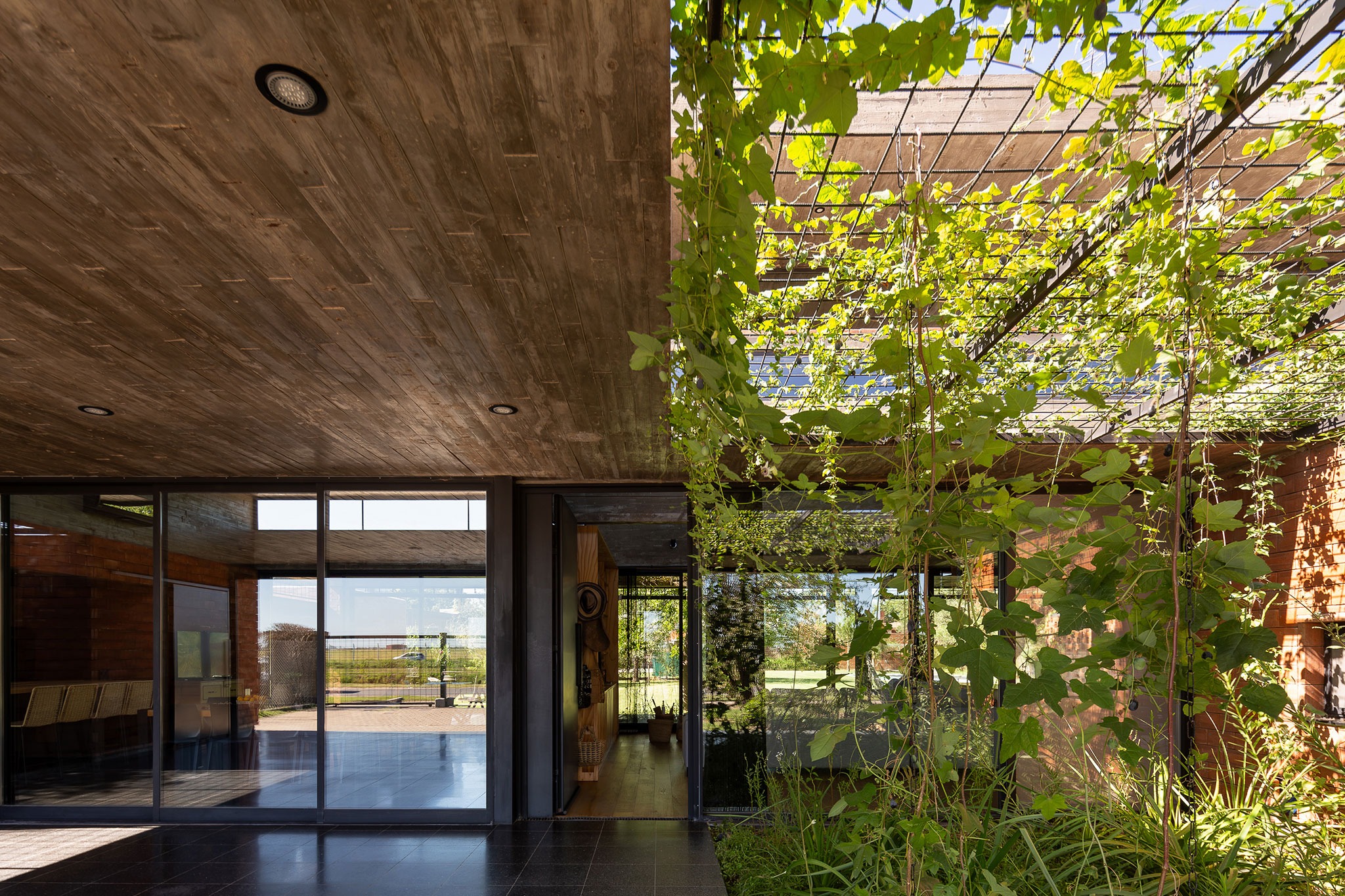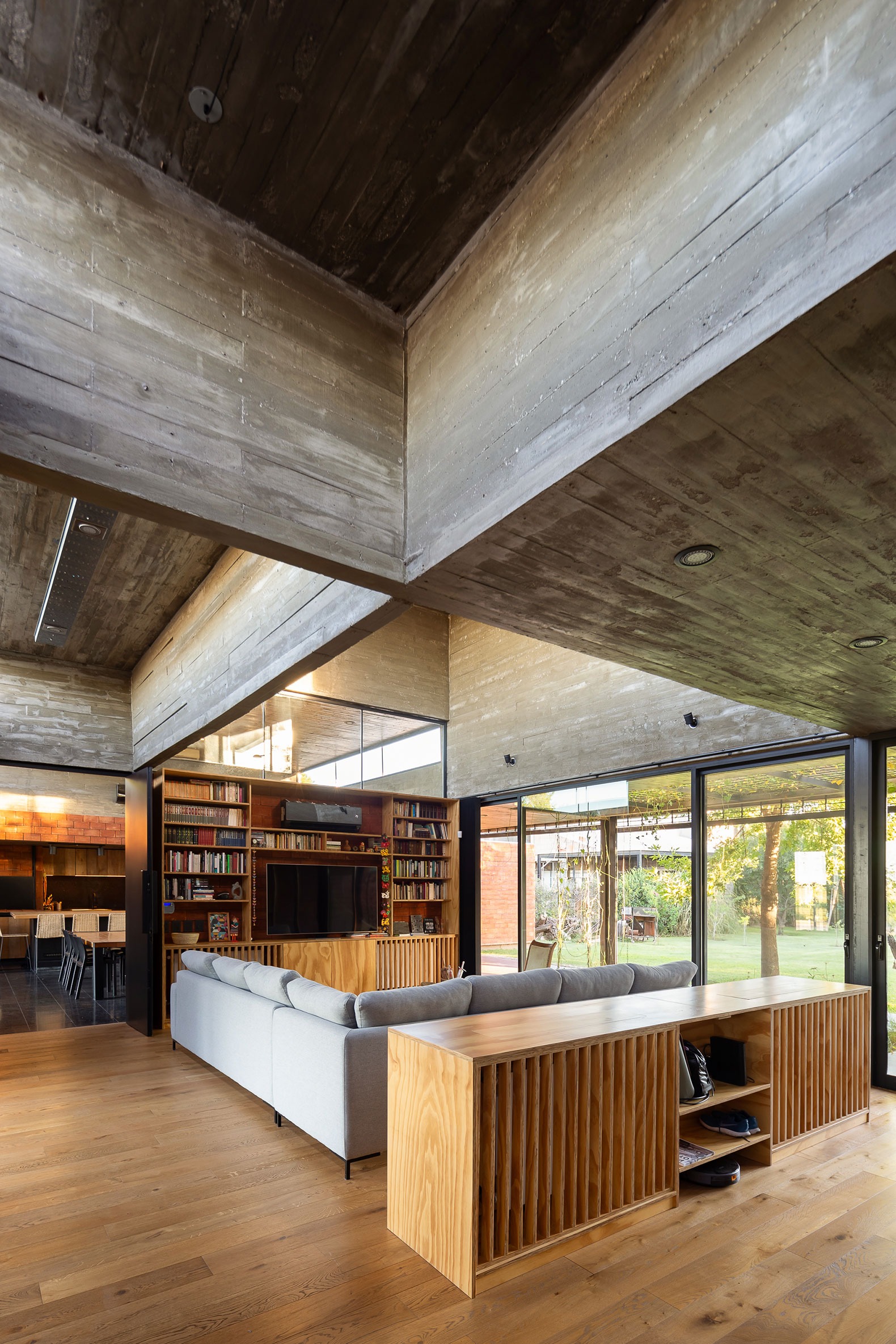
The project developed by Arquitectura Spinetta arranges the house around a large continuous space, while allowing it to be subdivided for simultaneous use. Through a play of volumes, the project places the private areas of the program in opaque volumes covered in red brick, and between them, the social meeting spaces open to the landscape.
The house intersperses constructed spaces with a total of seven patios full of vegetation, amidst a constant play of heights, windows and eaves that reflect the space-time in which they are located. Beams, partitions and slabs provide dynamism and spatial richness to the complex, while by opening gaps at different heights, natural light and ventilation enter the interior from different angles.

The House of seven Patios by Arquitectura Spinetta. Photograph by Ramiro Sosa fotografía.
Project description by Arquitectura Spinetta
The “House of 7 Patios” is located on a large plot of land in Funes, a town near Rosario that has seen accelerated growth in recent years and is characterized by large plots of land with vegetation and low population density.
The project had the complexity of being built over 4 years in 3 stages, going through a global pandemic, with a family living in the existing house located on the same site as the new project. In each phase, the existence of a program of living needs had to be guaranteed, also ensuring a friendly link between the construction of the new house and daily life to guarantee good family coexistence.

The lot has the particularity of being located in front of the Rosario airport runway and the train tracks, which means that it has a constant circulation of trains and planes that seduce and attract attention. Both pre-existing elements have a strong horizontality as elements of the environment and it was a decision to take them and enhance them in the project through the visuals. There were also sentimental reasons because that place contained the grandparents' house, a family meeting place in childhood and summer, closely linked to aeromodelling and fans of the manufacture of balsa wood airplanes, so that the presence of airplanes in daily life and the enjoyment of watching them pass by, would be a strong family legacy to keep in mind in the project.
The house is implanted on the land horizontally and extended across its entire width. In the project, built spaces are interspersed with a total of 7 patios with vegetation. The most private spaces are housed in opaque volumes covered in red brick located at the two ends of the lot towards the dividing walls, and between them, the social meeting spaces open in a frank manner towards the landscape. The program is developed almost entirely on the ground floor, only the work desk is located on the upper floor for greater privacy.

The decision was made to incorporate as a basis for the project the possibility of having two views: an introspective one that the patios allow for privacy, and another vast and wide view of the landscape through the large glass surfaces that give onto the galleries. This duality is strengthened by the balance between both: the more closed for moments of rest and privacy coexisting with the open and transparent in spaces prepared to accommodate the different family activities of social gathering.
The living, dining, kitchen and shed environments are housed in a large continuous space that at the same time allows for subdivision to be used simultaneously. Generous dimensions, openings at different heights that allow light to enter from different angles and the design of beams and slabs that go up and down, give it dynamism and spatial richness. From inside them it is possible to broaden the view in the perception of the landscape: the airport runway, airplane landings, the passing train, the garden and the trees in the center of the block. It is the exterior that is internalized and forms part of living in the house. This transition between interior and exterior has a sensorial thickness as it is mediated by patios with vegetation, eaves, galleries, shutters and mobile curtains, which as filters and climate conditioning allow unique spatial experiences where the senses and emotions are at play. The enclosures of the galleries consist of lifting curtains (open like bars or blinds in garages) and metal shutters rescued from demolitions, designed with a folding-sliding system that allows total closure for security or opening to enjoy the surroundings.

Regarding the materiality of the project, a system of slabs, partitions and exposed concrete beams is arranged, generating different horizontal planes with displacement of some slabs and interruptions of gaps for patios, causing upper openings for light/sun entry and double heights. The concrete slab at level 2.70m seems to be resting on the red walls that hide the calibration of the columns of the supporting structure inside. These walls are made of four layers: double hollow brick with an air chamber in the middle, which are then covered on both sides by flat brick walls without joints. Noble materials such as common bricks and exposed concrete are used, which entail low maintenance and aging in a long term.
The patios - according to J.L. Borges, "those channeled skies" - introduce the levels of privacy required for each sector of the house. They allow the entry of sunlight and ventilation to all rooms through the design of eaves and orientation of openings, so that it is possible to dictate the needs according to the seasons of the year. At the same time, they resolve the issue of security: the metal enclosures at the top do not interrupt the view of the vegetation at eye level. Each of the patios has a particular design that gives it its own identity. The South Patio covers the privacy of the adult bedroom and is a microclimate for hummingbirds, bumblebees and butterflies that seek the guaranitic sage and milkweed. The Side Patio aims to be tropical with the rainwater collected by the gargoyle and its variety of palm trees and papyrus. The North Patio, which frames the children's bedrooms, takes advantage of the long flowering of the plumbago jasmine that is interwoven with the brick screened wall, to protect the necessary privacy from the street. It has entry of northern sunlight in winter that the eaves prevent in summer. The two Central Patios on either side of the living room have vegetation based on pampas grasslands and native climbing and hanging vines, forming a spatiality with vegetal thickness. These are species collected from the surrounding ecosystem that together generate a continuity of habitat towards the interior of domestic gardens and will provide shelter and food for insects, invertebrates, birds and small animals.

The bioclimatic strategies adopted respond to the need to promote certain sustainable practices such as cross ventilation, eaves for protection from the sun in summer, double walls and DVH glass for thermal insulation, rainwater collection for irrigation, solar water heater for hot water, native vegetation in the patios as an extension of the biological corridors, separation of waste for recycling and composting on the land.
The unity of this work is presented with the presence of light in all the rooms. In winter it is the bright sun as a blanket. In summer it is the luminosity of the day without the suffocating rays. A set of patios, a game of heights, windows and eaves so that in each season only what is desired passes through. A succession of microcosms that allow the house to be inhabited by stopping the passage, through sensorial experiences of apprehension of the environment. The movement in space-time is enriched through sounds and smells, textures and temperature of the materials, the wind in the plants, the light that enters filtered by the vegetation or forcefully through the openings, hummingbirds and butterflies that surprise, the colors that accompany the seasons of the year, everything is assembled in the different scenarios that consolidate the internal universe of the house and its inhabitants. Architecture is presented as a device through which the exchanges between climate, nature and people can be regulated, inviting us to participate in the daily construction of a domestic scenario committed to the environment it inhabits.












































































